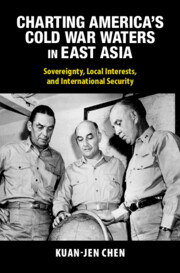 Charting America's Cold War Waters in East Asia
Charting America's Cold War Waters in East Asia Book contents
- Charting America’s Cold War Waters in East Asia
- Cambridge Studies in US Foreign Relations
- Charting America’s Cold War Waters in East Asia
- Copyright page
- Contents
- Figures, Tables, and Maps
- Abbreviations
- Conventions
- Acknowledgements
- Introduction
- 1 Finding a Local Partner in Post-war Maritime East Asia
- 2 The Creation of a Mainland-Based Forward Strategy
- 3 Vying for Top Dog: The Navy–Army Struggle in Maritime East Asia
- 4 Termination of the Mainland-Based Forward Strategy
- 5 The 1950 Crises and America’s Changing Posture of Defence
- 6 The Making of a New Maritime Strategy
- 7 The International Law of the Sea and America’s Unreliable Partners
- 8 America’s Strange Bedfellows in the International Arena
- 9 Fishing for Protein in Cold War East Asia
- 10 Jostling for Position: Black Gold, Natural Resource Exploration, and Shifting Political Contours
- Epilogue
- Bibliography
- Index
3 - Vying for Top Dog: The Navy–Army Struggle in Maritime East Asia
Published online by Cambridge University Press: 23 May 2024
- Charting America’s Cold War Waters in East Asia
- Cambridge Studies in US Foreign Relations
- Charting America’s Cold War Waters in East Asia
- Copyright page
- Contents
- Figures, Tables, and Maps
- Abbreviations
- Conventions
- Acknowledgements
- Introduction
- 1 Finding a Local Partner in Post-war Maritime East Asia
- 2 The Creation of a Mainland-Based Forward Strategy
- 3 Vying for Top Dog: The Navy–Army Struggle in Maritime East Asia
- 4 Termination of the Mainland-Based Forward Strategy
- 5 The 1950 Crises and America’s Changing Posture of Defence
- 6 The Making of a New Maritime Strategy
- 7 The International Law of the Sea and America’s Unreliable Partners
- 8 America’s Strange Bedfellows in the International Arena
- 9 Fishing for Protein in Cold War East Asia
- 10 Jostling for Position: Black Gold, Natural Resource Exploration, and Shifting Political Contours
- Epilogue
- Bibliography
- Index
Summary
The author takes a detailed look at decision-makers’ plans for unified commands in the Pacific from 1947 onwards and elaborates on the debates within the Truman administration over naval deployment in post-war East Asia and its overall international security goals. The author further argues that the wartime competition for leadership in the Pacific between MacArthur and Nimitz did not end with World War II but persisted in the immediate post-war period. The United States regarded the Pacific as its lake, but the United States’ Navy–Army division resulted in it being a divided lake in terms of authority: the Army led the Far East Command and the Navy held the Pacific Command according to the 1947 unified command plan. This chapter also shows the inextricable link between international and regional turbulence and America’s construction of unified commands in the Pacific. Mainland China, which the US Navy chose as a springboard where it could build its maritime order in post-war East Asia, was not included in either the Far East Command or the Pacific Command. Truman administration’s ambiguous China policy and the Navy–Army competition for leadership in the Pacific blurred the contours of America’s maritime East Asia.
Keywords
- Type
- Chapter
- Information
- Charting America's Cold War Waters in East AsiaSovereignty, Local Interests, and International Security, pp. 78 - 101Publisher: Cambridge University PressPrint publication year: 2024


